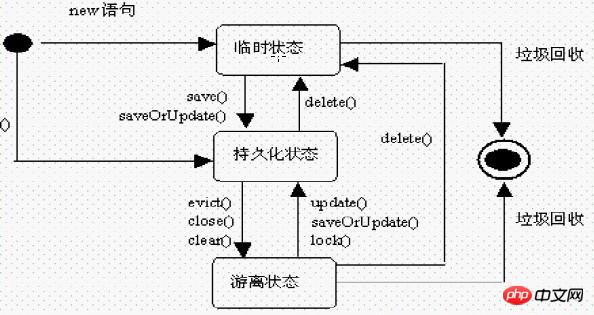This article mainly introduces the in-depth understanding of the three states of hibernate, which mainly include transient (transient state), persistent (persistent state) and detached (offline state). Interested students can learn more
Anyone who has studied hibernate may know that hibernate has three states, transient (transient state), persistent (persistent state) and detached (offline state). You may also know the difference between these three, such as transient The state is that an object has just been created and has not been saved in the database. The persistent state means that it has been saved in the database. The offline state means that the object exists in the database but does not exist in the session. But do you know all about the special methods of hibernate's session? Or can you quickly see at a glance how many SQL statements a test case will issue after repeatedly calling the session's save and update methods? This essay will give you the answer. This essay will use a large number of test cases to cover up the changes in these three states of hibernate. I believe that after reading this essay you will have a deeper understanding of the three states of hibernate. understand.
Okay, let’s not talk nonsense. I believe everyone knows the meaning of these three states of hibernate, so let’s start our journey into the three states of hibernate through a picture.

1.TestTransient
##
session = HibernateUtil.openSession();
session.beginTransaction();
User user = new User();
user.setUsername("aaa");
user.setPassword("aaa");
user.setBorn(new Date());
/*
* 以上user就是一个Transient(瞬时状态),此时user并没有被session进行托管,即在session的
* 缓存中还不存在user这个对象,当执行完save方法后,此时user被session托管,并且数据库中存在了该对象
* user就变成了一个Persistent(持久化对象)
*/
session.save(user);
session.getTransaction().commit();At this time we know that hibernate will issue an insert statement, after executing the save method, the user object becomes a persistent object The code is as follows:
Hibernate: insert into t_user (born, password, username) values (?, ?, ?)
2.TestPersistent01
##
session = HibernateUtil.openSession();
session.beginTransaction();
User user = new User();
user.setUsername("aaa");
user.setPassword("aaa");
user.setBorn(new Date());
//以上u就是Transient(瞬时状态),表示没有被session管理并且数据库中没有
//执行save之后,被session所管理,而且,数据库中已经存在,此时就是Persistent状态
session.save(user);
//此时u是持久化状态,已经被session所管理,当在提交时,会把session中的对象和目前的对象进行比较
//如果两个对象中的值不一致就会继续发出相应的sql语句
user.setPassword("bbb");
//此时会发出2条sql,一条用户做插入,一条用来做更新
session.getTransaction().commit();value. Then when the transaction is submitted, the hibernate object will take the current user object. Compare it with the user object stored in the session cache. If the two objects are the same, no update statement will be sent. Otherwise, if the two objects are different, the update statement will be issued.
Hibernate: insert into t_user (born, password, username) values (?, ?, ?) Hibernate: update t_user set born=?, password=?, username=? where id=?
SimpleDateFormat sdf = new SimpleDateFormat("yyyy-MM-dd");
session = HibernateUtil.openSession();
session.beginTransaction();
User u = new User();
u.setBorn(new Date());
u.setUsername("zhangsan");
u.setPassword("zhangsan");
session.save(u);
u.setPassword("222");
//该条语句没有意义
session.save(u);
u.setPassword("zhangsan111");
//没有意义
session.update(u);
u.setBorn(sdf.parse("1988-12-22"));
//没有意义
session.update(u);
session.getTransaction().commit();Hibernate: insert into t_user (born, password, username) values (?, ?, ?) Hibernate: update t_user set born=?, password=?, username=? where id=?
SimpleDateFormat sdf = new SimpleDateFormat("yyyy-MM-dd");
session = HibernateUtil.openSession();
session.beginTransaction();
User u = new User();
u.setBorn(sdf.parse("1976-2-3"));
u.setUsername("zhangsan2");
u.setPassword("zhangsan2");
session.save(u);
/*
* 以下三条语句没有任何意义
*/
session.save(u);
session.update(u);
session.update(u);
u.setUsername("zhangsan3");
session.getTransaction().commit();Hibernate: insert into t_user (born, password, username) values (?, ?, ?) Hibernate: update t_user set born=?, password=?, username=? where id=?
session = HibernateUtil.openSession();
session.beginTransaction();
//此时u是Persistent
User u = (User)session.load(User.class, 4);
//由于u这个对象和session中的对象不一致,所以会发出sql完成更新
u.setUsername("bbb");
session.getTransaction().commit();Hibernate: select user0_.id as id0_0_, user0_.born as born0_0_, user0_.password as password0_0_, user0_.username as username0_0_ from t_user user0_ where user0_.id=? Hibernate: update t_user set born=?, password=?, username=? where id=?
session = HibernateUtil.openSession();
session.beginTransaction();
//此时u是Persistent
User u = (User)session.load(User.class, 4);
u.setUsername("123");
//清空session
session.clear();
session.getTransaction().commit();The code is as follows:
Hibernate: select user0_.id as id0_0_, user0_.born as born0_0_, user0_.password as password0_0_, user0_.username as username0_0_ from t_user user0_ where user0_.id=?
session = HibernateUtil.openSession();
session.beginTransaction();
//此时u是一个离线对象,没有被session托管
User u = new User();
u.setId(4);
u.setPassword("hahahaha");
//当执行save的时候总是会添加一条数据,此时id就会根据Hibernate所定义的规则来生成
session.save(u);
session.getTransaction().commit();
我们看到,当调用了u.setId(4)时,此时u是一个离线的对象,因为数据库中存在id=4的这个对象,但是该对象又没有被session所托管,所以这个对象就是离线的对象,要使离线对象变成一个持久化的对象,应该调用什么方法呢?我们知道调用save方法,可以将一个对象变成一个持久化对象,但是,当save一执行的时候,此时hibernate会根据id的生成策略往数据库中再插入一条数据,所以如果调用save方法,此时数据库会发送一条插入的语句:
Hibernate: insert into t_user (born, password, username) values (?, ?, ?)
所以对于离线对象,如果要使其变成持久化对象的话,我们不能使用save方法,而应该使用update方法
8.TestDetached02
SimpleDateFormat sdf = new SimpleDateFormat("yyyy-MM-dd");
session = HibernateUtil.openSession();
session.beginTransaction();
User u = new User();
u.setId(5);
//完成update之后也会变成持久化状态
session.update(u);
u.setBorn(sdf.parse("1998-12-22"));
u.setPassword("world");
u.setUsername("world");
//会发出一条sql
session.update(u);
session.getTransaction().commit();此时我们看到,当调用了update方法以后,此时u已经变成了一个持久化的对象,那么如果此时对u对象进行修改操作后,在事务提交的时候,则会拿该对象和session中刚保存的持久化对象进行比较,如果不同就发一条sql语句
Hibernate: update t_user set born=?, password=?, username=? where id=?
9.TestDetached03
SimpleDateFormat sdf = new SimpleDateFormat("yyyy-MM-dd");
session = HibernateUtil.openSession();
session.beginTransaction();
User u = new User();
u.setId(5);
//完成update之后也会变成持久化状态
session.update(u);
u.setBorn(sdf.parse("1998-12-22"));
u.setPassword("lisi");
u.setUsername("lisi");
//会抛出异常
u.setId(333);
session.getTransaction().commit();我们看这个例子,前面的操作一样,调用update方法后,user变成了一个持久化对象,在对user进行一些修改后,此时又通过 u.setId(333)方法设置了u的ID,那么这个时候,hibernate会报错,因为我们的u当前已经是一个持久化对象,如果试图修改一个持久化对象的ID的值的话,就会抛出异常,这点要特别注意
复制代码 代码如下:
org.hibernate.HibernateException: identifier of an instance of com.xiaoluo.bean.User was altered from 5 to 333
10.TestDetached04
session = HibernateUtil.openSession();
session.beginTransaction();
User u = new User();
u.setId(5);
//现在u就是transient对象
session.delete(u);
//此时u已经是瞬时对象,不会被session和数据库所管理
u.setPassword("wangwu");
session.getTransaction().commit();接着我们来看这个例子,这里在调用了session.delete()方法以后,此时后u就会变成一个瞬时对象,因为此时数据库中已经不存在该对象了,既然u已经是一个瞬时对象了,那么对u再进行各种修改操作的话,hibernate也不会发送任何的修改语句,因此这里只会 有一条 delete的语句发生:
Hibernate: delete from t_user where id=?
11.TestDetached05
session = HibernateUtil.openSession();
session.beginTransaction();
User u = new User();
u.setId(4);
u.setPassword("zhaoliu");
//如果u是离线状态就执行update操作,如果是瞬时状态就执行Save操作
//但是注意:该方法并不常用
session.saveOrUpdate(u);
session.getTransaction().commit();这里我们来看看 saveOrUpdate这个方法,这个方法其实是一个"偷懒"的方法,如果对象是一个离线对象,那么在执行这个方法后,其实是调用了update方法,如果对象是一个瞬时对象,则会调用save方法,记住:如果对象设置了ID值,例如u.setId(4),那么该对象会被假设当作一个离线对象,此时就会执行update操作。
Hibernate: update t_user set born=?, password=?, username=? where id=?
如果此时我将u.setId(4)这句话注释掉,那么此时u就是一个瞬时的对象,那么此时就会执行save操作,就会发送一条insert语句
Hibernate: insert into t_user (born, password, username) values (?, ?, ?)
12.TestDetached06
session = HibernateUtil.openSession();
session.beginTransaction();
//u1已经是持久化状态
User u1 = (User)session.load(User.class, 3);
System.out.println(u1.getUsername());
//u2是离线状态
User u2 = new User();
u2.setId(3);
u2.setPassword("123456789");
//此时u2将会变成持久化状态,在session的缓存中就存在了两份同样的对象,在session中不能存在两份拷贝,否则会抛出异常
session.saveOrUpdate(u2);我们再来看一下这个例子,此时我们的u1已经是持久化的对象了,保存在session缓存中,u2通过调用saveOrUpdate方法后也变成了一个持久化的对象,此时也会保存在session缓存中,这个时候session缓存中就存在了一个持久化对象有两个引用拷贝了,这个时候hibernate就会报错
复制代码 代码如下:
org.hibernate.NonUniqueObjectException: a different object with the same identifier value was already associated with the session: [com.xiaoluo.bean.User#3]
一个session中不能存在对一个持久化对象的双重copy的,要解决这个方法,我们这里又要介绍session的另一个方法 merge方法,这个方法的作用就是解决一个持久化对象两分拷贝的问题,这个方法会将两个对象合并在一起成为一个对象。
session = HibernateUtil.openSession();
session.beginTransaction();
//u1已经是持久化状态
User u1 = (User)session.load(User.class, 3);
System.out.println(u1.getUsername());
//u2是离线状态
User u2 = new User();
u2.setId(3);
u2.setPassword("123456789");
//此时u2将会变成持久化状态,在session的缓存中就存在了两份同样的对象,在session中不能存在两份拷贝,否则会抛出异常
// session.saveOrUpdate(u2);
//merge方法会判断session中是否已经存在同一个对象,如果存在就将两个对象合并
session.merge(u2);
//最佳实践:merge一般不用
session.getTransaction().commit();我们看到通过调用了merge方法以后,此时会将session中的两个持久化对象合并为一个对象,但是merge方法不建议被使用
Hibernate: select user0_.id as id0_0_, user0_.born as born0_0_, user0_.password as password0_0_, user0_.username as username0_0_ from t_user user0_ where user0_.id=? zhangsan Hibernate: update t_user set born=?, password=?, username=? where id=?
终于写完了本篇随笔,本篇随笔可能概念性的内容比较少,基本都是通过测试用例来分析hibernate的三种状态可能会出现的各种情况。
最后总结一下:
①.对于刚创建的一个对象,如果session中和数据库中都不存在该对象,那么该对象就是瞬时对象(Transient)
②. Calling the save method on a transient object, or calling the update method on an offline object can make the object a persistent object. If the object is a persistent object, any modifications to the object will be made only when the transaction is committed. Compare with it, if different, send an update statement, otherwise no statement will be sent
③. The offline object is that the object exists in the database, but the object is not hosted by the session
【Related Recommendations】
1. Special Recommendation: "php Programmer Toolbox" V0.1 version download
The above is the detailed content of Detailed explanation of examples of hibernate status. For more information, please follow other related articles on the PHP Chinese website!